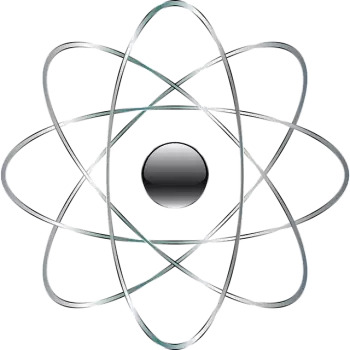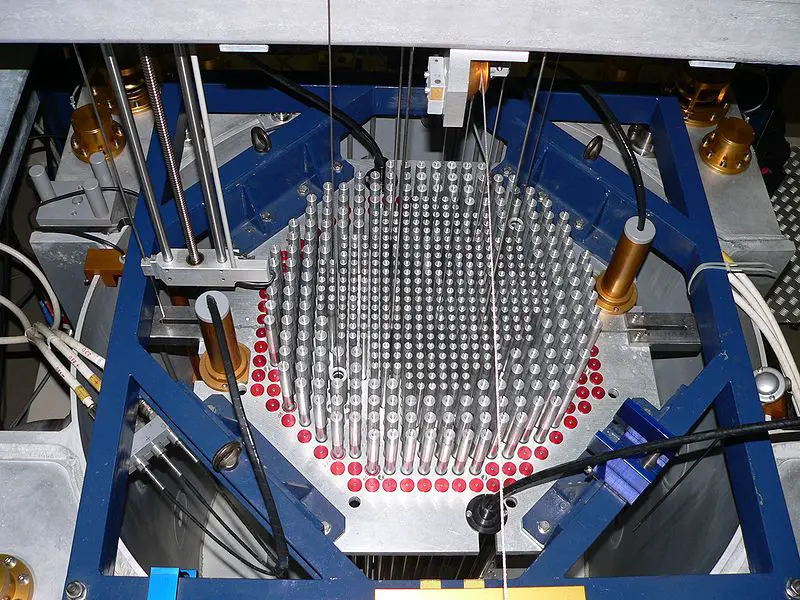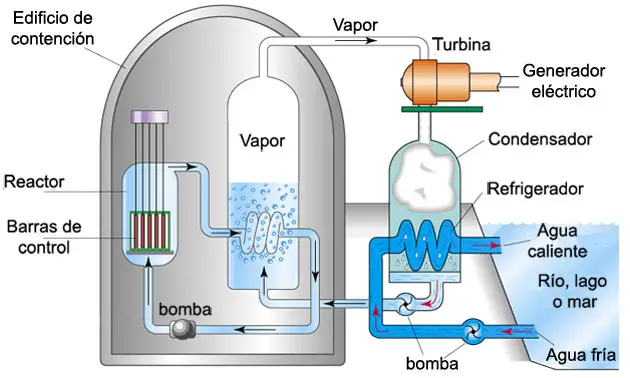
A nuclear power plant is a power generation facility that uses the energy released by nuclear reactions to produce electricity. Essentially, it is a type of thermal power plant that uses nuclear fission as a heat source, rather than fossil fuels such as coal or gas.
The basic operation of a nuclear power plant shares principles with other thermal power plants: heat is generated from an energy source, which is used to produce steam and drive a turbine connected to an electric generator.
What is a nuclear power plant?
A nuclear power plant, also known as a nuclear power plant, is a type of thermal power plant whose energy source comes from nuclear reactions, specifically from the process of nuclear fission.
These facilities are designed to produce large amounts of electricity on a constant basis, taking advantage of the enormous amount of energy contained in the nucleus of atoms.
Although their operation is similar to that of other thermal power plants - where a heat source is used to generate steam and drive a turbine connected to an electric generator - nuclear power plants are distinguished by the use of radioactive materials such as uranium-235 or plutonium-239 as fuel.
What is a nuclear power plant used for?
 The primary purpose of a nuclear power plant is to produce electricity efficiently and continuously. Through the process of nuclear fission, these facilities generate heat that is used to produce steam, which then drives turbines connected to electric generators to generate electricity.
The primary purpose of a nuclear power plant is to produce electricity efficiently and continuously. Through the process of nuclear fission, these facilities generate heat that is used to produce steam, which then drives turbines connected to electric generators to generate electricity.
Other purposes of nuclear power plants are the reduction of greenhouse gas emissions. Nuclear power plants emit very low amounts of carbon dioxide (CO 2 ) during electricity generation compared to power plants that burn fossil fuels such as coal and natural gas.
In addition to generating electricity, some nuclear power plants are used for scientific and medical research. For example, they produce radioactive isotopes used in medicine for diagnosing and treating diseases, as well as for research in nuclear physics.
Parts of a nuclear power plant
Nuclear power plants can be divided into different components. The most important elements of a nuclear power plant are the following:
Reactor nuclear
The reactor is the central component of the plant, where the fission reaction takes place. Its main parts are:
- Nuclear fuel : Usually enriched uranium in the form of fuel rods.
- Moderator : A substance that slows down neutrons to maintain the chain reaction. This is usually light water, heavy water, or graphite.
- Control rods : Mechanisms that absorb neutrons to regulate or stop the nuclear reaction.
- Coolant : Fluid that extracts the heat generated in the reactor.
Steam generator
In pressurized water reactors (PWR), this component transfers heat from the primary coolant to the secondary circuit, where steam is generated to drive the turbines.
Turbine and generator
These are the elements that convert mechanical energy into electrical energy.
-
Turbine : Converts the thermal energy of steam into mechanical energy.
-
Generator : Transforms mechanical energy into usable electricity.
Condenser
The condenser cools the steam used in the turbines, converting it back into water for recirculation.
Refrigeration system
This system ensures the removal of waste heat from the reactor and condenser, using cooling towers or natural bodies of water.
Security systems
-
Containment : Structure that encloses the reactor to prevent the release of radioactive material into the environment.
-
Quick stop system : Allows the control rods to be inserted quickly to stop the reaction.
-
Redundant systems : Designed to ensure safe operation in the event of failures.
Basic operation
The operation of a nuclear power plant can be divided into several stages, all designed to convert the energy released by nuclear fission into electricity in an efficient and controlled manner:

1. Nuclear reaction in the reactor
The reactor is like the heart of the power plant. This is where the most important process takes place: nuclear fuel , such as uranium, undergoes a process called nuclear fission . Basically, we split large atoms into smaller pieces. And what happens when we break these atoms? According to what Einstein established, they release a huge amount of heat.
2. Heat transfer
The heat generated in the reactor is transferred to a cooling fluid (usually water) that circulates inside the reactor. This fluid is heated to extremely high temperatures.
3. Steam generation
The heated fluid is used to produce steam in a steam generator (in pressurized water reactors) or directly in the reactor (in boiling water reactors). The generated steam has high kinetic energy and is directed to the turbines.
4. Turbine movement
High-pressure steam moves the blades of a turbine, converting the thermal energy of the steam into mechanical energy.
5. Electricity generation
The turbine is coupled to an electric generator, which transforms mechanical energy into electricity using the principle of electromagnetic induction.
6. Condensation and recirculation
After passing through the turbines, the steam is cooled and condensed into water by a condenser. The water is returned to the cycle to be heated again, closing the circuit.
Types of nuclear power plants
Nuclear power plants are classified according to the type of reactor they use.
There are different types of nuclear reactors in power plants used for electricity production, all of which are fission reactors. The UN classifies them as follows:
- Pressurized water reactor (PWR and VVER). They use high pressure water to produce steam for steam generators. They have three circuits.
- Boiling water reactor (BWR): The second most common reactor in the world. Water boils, generating steam directly in the reactor core. They have only two circuits.
- The pressurized heavy water reactor (PHWR): Uses high-pressure heavy water as a neutron moderator and as a coolant.
- Gas-cooled reactor (GCR: AGR and Magnox): They use graphite as a neutron moderator and gaseous carbon dioxide as a coolant.
- Light water cooled graphite moderated reactor (LGR and RBMK): Models of Russian origin. "Light water" is normal water.
- Fast reactor (LBR, or LMFBR): It does not slow down the neutrons in the chain reaction and is cooled with liquid sodium. They are in the prototype and research phase.
- Molten salt reactors: They are a developing technology that uses a mixture of molten salt as a coolant and fuel.